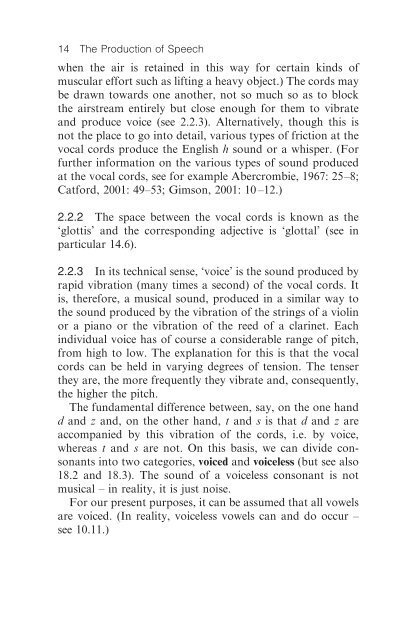An Introduction to French Pronunciation
An Introduction to French Pronunciation
An Introduction to French Pronunciation
Create successful ePaper yourself
Turn your PDF publications into a flip-book with our unique Google optimized e-Paper software.
14 The Production of Speech<br />
when the air is retained in this way for certain kinds of<br />
muscular effort such as lifting a heavy object.) The cords may<br />
be drawn <strong>to</strong>wards one another, not so much so as <strong>to</strong> block<br />
the airstream entirely but close enough for them <strong>to</strong> vibrate<br />
and produce voice (see 2.2.3). Alternatively, though this is<br />
not the place <strong>to</strong> go in<strong>to</strong> detail, various types of friction at the<br />
vocal cords produce the English h sound or a whisper. (For<br />
further information on the various types of sound produced<br />
at the vocal cords, see for example Abercrombie, 1967: 25–8;<br />
Catford, 2001: 49–53; Gimson, 2001: 10 –12.)<br />
2.2.2 The space between the vocal cords is known as the<br />
‘glottis’ and the corresponding adjective is ‘glottal’ (see in<br />
particular 14.6).<br />
2.2.3 In its technical sense, ‘voice’ is the sound produced by<br />
rapid vibration (many times a second) of the vocal cords. It<br />
is, therefore, a musical sound, produced in a similar way <strong>to</strong><br />
the sound produced by the vibration of the strings of a violin<br />
or a piano or the vibration of the reed of a clarinet. Each<br />
individual voice has of course a considerable range of pitch,<br />
from high <strong>to</strong> low. The explanation for this is that the vocal<br />
cords can be held in varying degrees of tension. The tenser<br />
they are, the more frequently they vibrate and, consequently,<br />
the higher the pitch.<br />
The fundamental difference between, say, on the one hand<br />
d and z and, on the other hand, t and s is that d and z are<br />
accompanied by this vibration of the cords, i.e. by voice,<br />
whereas t and s are not. On this basis, we can divide consonants<br />
in<strong>to</strong> two categories, voiced and voiceless (but see also<br />
18.2 and 18.3). The sound of a voiceless consonant is not<br />
musical – in reality, it is just noise.<br />
For our present purposes, it can be assumed that all vowels<br />
are voiced. (In reality, voiceless vowels can and do occur –<br />
see 10.11.)












